GOOD BOOKS?
The world premiere production of a new play about the Bible by Denis O’Hare and Lisa Peterson, The Good Book is impressive, complex, informative, and entertaining, perhaps even provocative and challenging to some viewers. Unfortunately, there seems to be simply too much going on, story-wise and production-wise, to make for a wholly satisfactory and compelling drama.
Let’s start with the story. How do you write a play about a book? O’Hare and Peterson have opted to do it through two interconnected modern narratives interspersed with historical vignettes about how the Bible was written and translated. Of the modern narratives, the one set in 1976 concerns a fifteen-year-old Catholic named Connor (Alex Weisman) who dreams of becoming a priest while coming to terms with his sexuality. The other, set in the present, tells the story of a middle-aged biblical studies professor named Miriam (Hollis Resnik) who has lost touch with the Lutheranism in which she was raised. Miriam’s secular outlook is challenged by her Christian students as well as by her Muslim lover.
As a theology graduate, I found Miriam’s lecture room scenes to be incredibly familiar and true-to-life, though cliché-ridden. And as a Catholic who nearly became a priest, I also found Connor’s story familiar and similarly marred down by cliché. Both narratives only work as well as they do by virtue of the fine performances given by Resnik and Weisman.
Into this mix of personal narratives is thrown some half-dozen historical vignettes spanning four millennia, which constantly jerk the reader backwards and forwards through time. Rather than portraying events described in the Bible, The Good Book imagines incidents illustrative of the Bible’s history, such as the carrying of scrolls into Babylonian exile. Occasionally, historical and modern scenes inexplicably overlap, as when Connor talks to the Apostle Paul and to King James I of England.
O’Hare and Peterson have packed a fair amount of biblical studies into the play, assisted by Margaret Mitchell, Dean of the University of Chicago Divinity School. References are made to the Documentary Hypothesis, the Synoptic Problem, and contemporary debates over gendered language. The authors’ balanced and objective presentation aims neither to denigrate nor promote Christian belief in the divine inspiration of the Bible, but is unabashedly written from within a Western Christian context. Surprisingly, little if any allowance seems to have been made for Jewish sensitivities. What is more surprising, perhaps shockingly so, is the complete absence of Jesus from The Good Book.
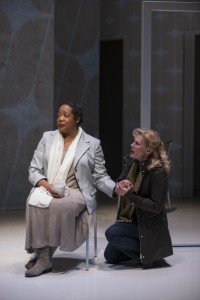 Now for the slightly overwrought production that could have been scaled back a bit. Although scenic designer Rachel Hauck goes spare with few props, bare surfaces, and blank walls, this enables Mike Tutaj to create a variety of projections, which are largely unreadable to those sitting on the far left and right sides. Linda Roethke’s costume designs are rather good overall, shifting between realistic modern and approximately ancient. Keith Parham’s practical lighting design enables smooth and rapid changes of mood and scene. Mark Bennett’s sound, however, is flawed by the unnecessary use of mics for the purpose of distorting actors’ voices. Moreover, snow effects are overused and often lead to the odd snowflake falling at the wrong moment. Perhaps the most effective use of technology in The Good Book is in the comic scene that sees Miriam Skyping with her overseas lover, hampered by static and buffering.
Now for the slightly overwrought production that could have been scaled back a bit. Although scenic designer Rachel Hauck goes spare with few props, bare surfaces, and blank walls, this enables Mike Tutaj to create a variety of projections, which are largely unreadable to those sitting on the far left and right sides. Linda Roethke’s costume designs are rather good overall, shifting between realistic modern and approximately ancient. Keith Parham’s practical lighting design enables smooth and rapid changes of mood and scene. Mark Bennett’s sound, however, is flawed by the unnecessary use of mics for the purpose of distorting actors’ voices. Moreover, snow effects are overused and often lead to the odd snowflake falling at the wrong moment. Perhaps the most effective use of technology in The Good Book is in the comic scene that sees Miriam Skyping with her overseas lover, hampered by static and buffering.
Above all, it counts a fine cast led by Resnik and Weisman. They are joined by Allen Gilmore, Erik Hellman, Kareem Bandealy, Jacqueline Williams, and Emjoy Gavino, each performing multiple roles, occasionally of the opposite sex. Apart from a few infelicities of accent and tone of voice, the acting is uniformly outstanding.
Lastly, why do O’Hare and Peterson name their new play The Good Book (singular) when they are at pains to point out in one of the opening scenes that the Bible is a collection of books (plural)? Does this title undermine the message or is it meant to highlight the very ambiguity, polyvalence, and pluriformity that make the Bible such an intriguing text? Whatever the answer, a similar tension and paradox seem to be present in this rather convoluted play and production.
The Good Book
Court Theatre, 5535 S. Ellis Ave.
Wed and Thurs at 7:30; Fri at 8;
Sat at 3 & 8; Sun at 2:30 & 7:30
scheduled to end on April 19, 2015
for tickets, call 773.753.4472 or visit www.CourtTheatre.org
for more info on Chicago Theater, visit www.TheatreinChicago.com
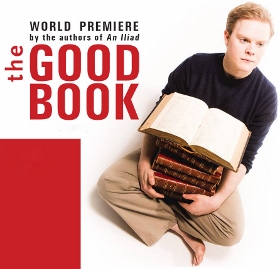
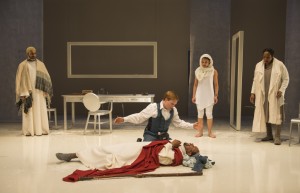
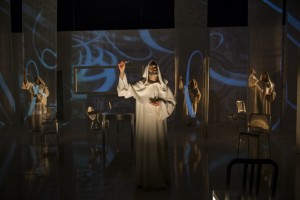
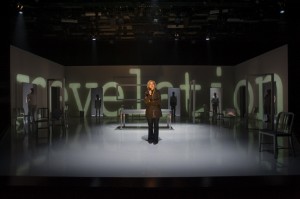
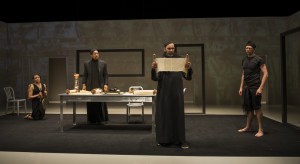
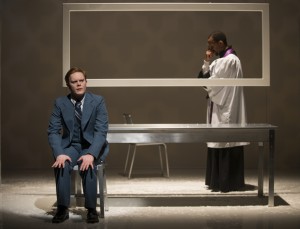
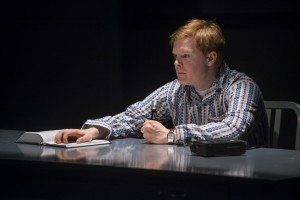
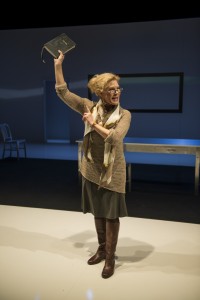
{ 1 comment… read it below or add one }
I loved the play. Found acting to be flawless. Enjoyed the humor. Had no problem with snowflakes falling or with sound. Really liked the ending as the play stayed true to Miriam’s character.